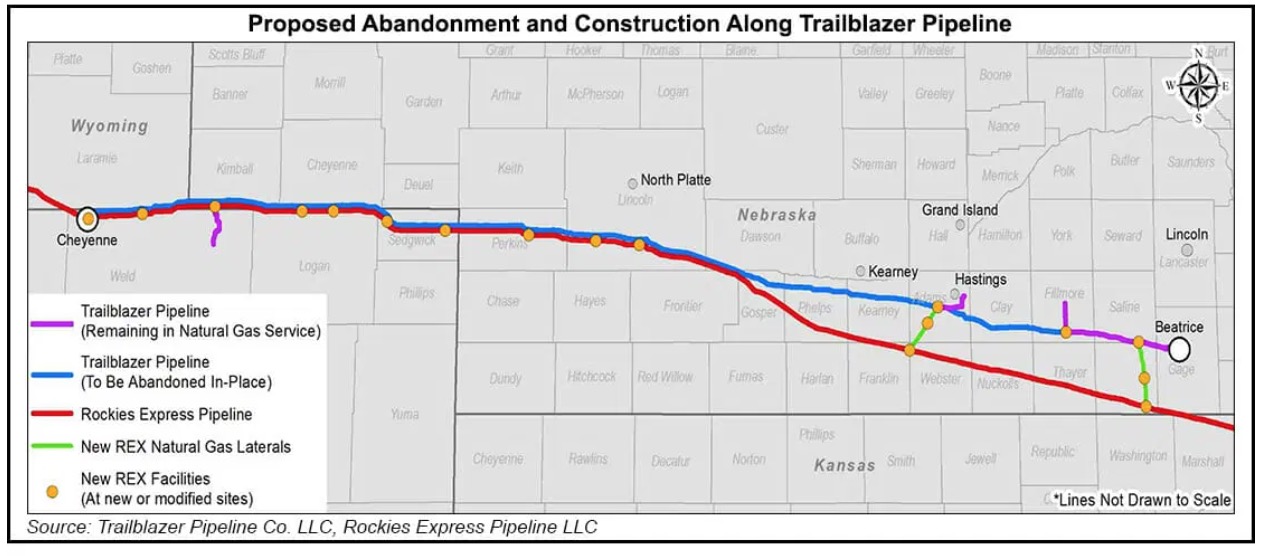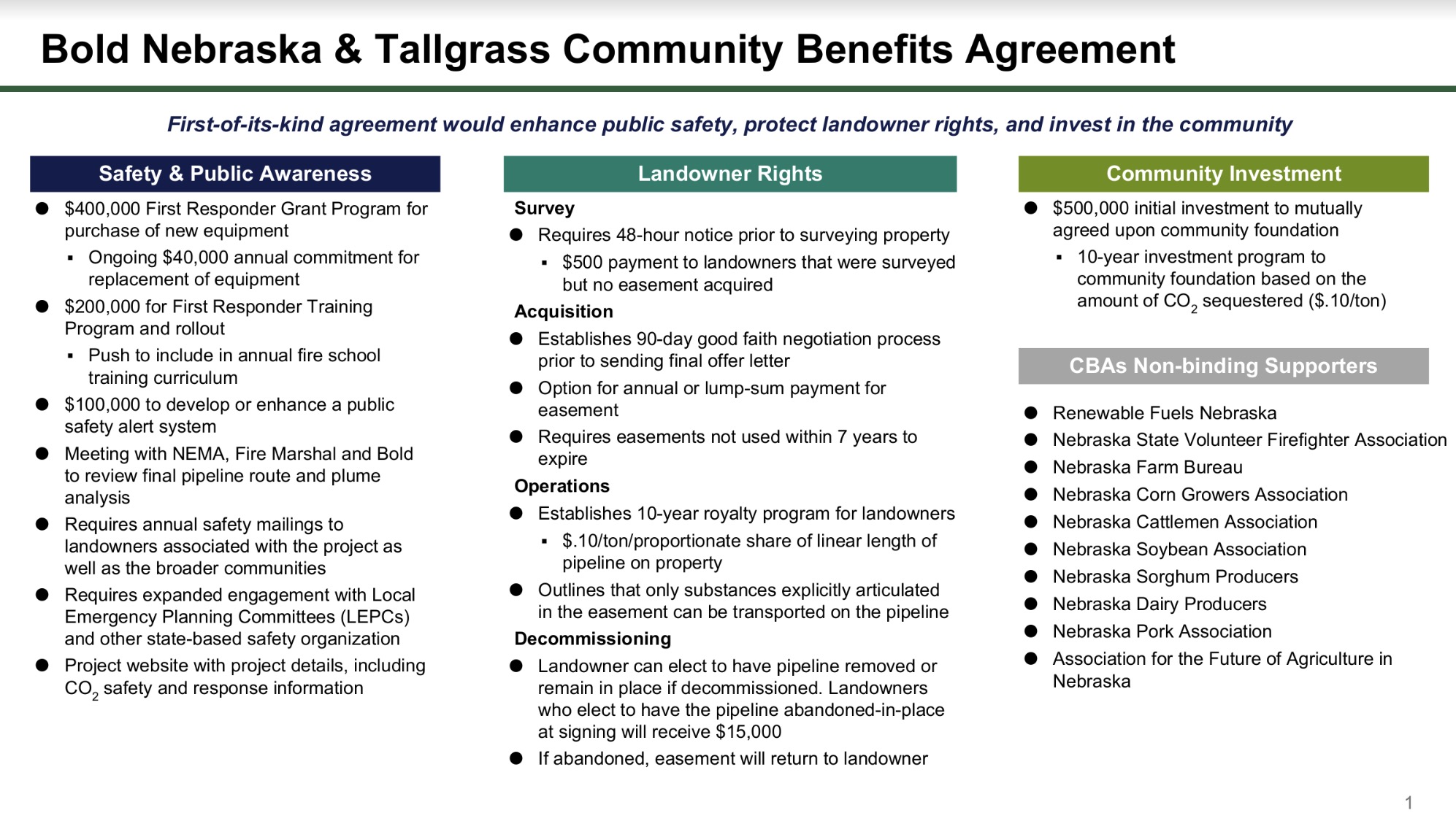
Update (4/9/24): Tallgrass, Bold Alliance, and Key Agricultural and First Responder Organizations Announce a Community Benefits Agreement
In the state of Nebraska, there is no state agency with authority over carbon dioxide (CO2) pipelines, after the Nebraska Public Service Commission issued a statement saying it had no authority under state laws, leaving landowners, counties and first responders to come up with measures to protect property rights, themselves and the communities impacted.
The Tallgrass Trailblazer methane gas pipeline was constructed in 1981 to carry gas across Wyoming, Colorado and Nebraska. The company recently applied for and was granted permission by the Federal Energy Regulatory Commission (FERC) to transition the existing gas pipeline to carry carbon dioxide, where it plans to connect with Midwest ethanol plants and collect CO2 emissions for transport via the Trailblazer pipeline for underground sequestration.
Methane gas pipelines are regulated by FERC, which holds the power to grant eminent domain authority to corporations to seize landowners’ property against their will for a project. Carbon pipelines do not have an equivalent to FERC for the rules and regulations around eminent domain, siting and decommissioning on a national level.
In the case of the Tallgrass Trailblazer pipeline, in this particular situation with this particular project in the state of Nebraska, with the current lack of any regulation in Nebraska — landowners, first responders and communities did not have enough votes in the legislature to put basic protections into law. This fundamental reason is why Bold approached Tallgrass to seek protections and benefits in writing of the Community Benefits Agreement.
An easement contract for the existing gas pipeline was already negotiated decades ago, and that methane gas pipeline was authorized by the Federal Energy Regulatory Agency (FERC) which approved the company’s plan to take the gas line out of service, and convert it to instead carry CO2.
Currently, the U.S. Department of Transportation’s Pipeline and Hazardous Materials Safety Administration (PHMSA) is working on updating regulations for carbon pipelines — in the wake of the 2020 CO2 pipeline rupture incident in Satartia, MS that forced the evacuation of hundreds and sent dozens to the hospital, with some reporting negative health impacts to this day.
Under this set of circumstances, Tallgrass landowners are in a position where they cannot fight eminent domain to stop a pipeline that is already in the ground on their property. Bold has for years urged the Nebraska Legislature to pass a number of bills that would provide added protections to landowners against eminent domain, enhance decommissioning plans for equipment after the life of a pipeline, and provide more comprehensive financial compensation for landowners and communities that shoulder the risks and burdens of these projects.
With no Nebraska state laws in existence to protect Tallgrass landowners, Bold realized an opportunity to seek some protections through a unique “Community Benefits Agreement” with the company, which also includes a number of other local community, Agricultural and first responder organizations. The Agreement includes financial benefits directly into the pockets of landowners and protections that would not have otherwise been available to landowners, first responders and the impacted communities in Nebraska.
While Bold entered into this Community Benefits Agreement with Tallgrass within the state of Nebraska, Bold does not see any path to a similar community benefits agreement, for instance, with Summit Carbon Solutions — which has already sued hundreds of landowners seeking survey access against their will, and has threatened to use eminent domain from day one to seize property from unwilling landowners. Summit has continued to show they do not care about landowners, first responders or communities in the path of their new pipeline infrastructure project.
A number of meetings are being scheduled to introduce the Community Benefits Agreement to communities within Nebraska that are impacted by the Tallgrass Trailblazer gas-to-CO2 conversion pipeline, in addition to a virtual Zoom meeting for Tallgrass landowners.
FOR IMMEDIATE RELEASE: April 9, 2024
Tallgrass, Bold Alliance, and Key Agricultural and First Responder Organizations Announce a Community Benefits Agreement
First-of-its-kind agreement establishes significant collaborative initiatives for landowners, public safety and community investment.
Lincoln, Neb. — Tallgrass, Bold Alliance, and multiple organizations across Nebraska announced a first-of-its-kind Community Benefits Agreement (CBA) associated with the Tallgrass Trailblazer carbon dioxide (CO2) sequestration project. The agreement between Tallgrass and Bold Alliance received endorsements from 11 statewide organizations, including Renewable Fuels Nebraska, the Nebraska State Volunteer Firefighter Association, the Nebraska Farm Bureau, the Nebraska Corn Growers Association, the Nebraska Cattlemen Association, the Nebraska Farmers Union, the Nebraska Soybean Association, the Nebraska Sorghum Producers, the Nebraska Dairy Producers, the Nebraska Pork Association and We Support AG. This landmark agreement sets a new precedent for pipeline infrastructure by establishing a series of community initiatives as well as creating rigorous landowner rights protections throughout the pipeline’s life cycle, from early project development through easement negotiations, operations, and decommissioning.
Other near and long-term benefits provisioned by the CBA include:
- A $500,000 funding commitment to nonprofits in the counties associated with the project.
- A $400,000 funding commitment to equip first responders throughout the development of the project, as well as ongoing annual funding to support replenishing and replacing essential equipment once the project is operational.
- There is a $200,000 funding commitment to train first responders as the project comes online, as well as an annual obligation, once operational, to provide public safety notifications to the families who live along the pipeline right of way.
- A requirement, at the time of decommissioning, that the easements are returned to landowners who may elect to have the pipeline abandoned in place or removed from their property.
The CBA additionally establishes a 10-year, two-part, shared-value program. By achieving operations on schedule, this program establishes provisions for landowners to receive an annual royalty payment and for a community foundation to receive an annual endowment — based on the total amount of CO2 the project sequesters. The annual royalty payment program for landowners applies not only to future easement negotiations, but also to landowners who have already signed easements for the CO2 pipeline.
“Bold believes that those who live in our rural towns and whose land is needed to develop American energy should receive direct financial and community benefits,” said Jane Kleeb, founder of Bold Alliance. “Tallgrass’s existing pipeline was initially built for natural gas delivery, and the conversion they are undertaking to transport carbon dioxide highlights the need for additional community benefits which are met under this agreement,” Kleeb continued. “Tallgrass is the first pipeline company we have encountered that has been willing to engage proactively, acknowledge the need for the landowner benefits that Bold fights to achieve, and genuinely commit itself to addressing those benefits by written agreement. The commitments between Bold and Tallgrass must set a standard for future energy infrastructure developers and for future regulatory reform that ensures stronger community and landowner benefits are enshrined in our state and federal laws.”
“We appreciate the time and effort that Bold Alliance and so many organizations across Nebraska have invested to achieve this milestone. Everyone involved worked hard to bridge the challenges of reaching a groundbreaking agreement like this one because of a common commitment to seeing Nebraska win. This project is a critical element of Nebraska’s bioeconomy — creating new markets and increased value for the biofuels industry, the family farms who supply them, and the communities they call home,” said Kyle Quackenbush, Segment President of Tallgrass. “At Tallgrass, our pipeline infrastructure has been safely powering Nebraska’s economic growth for decades. We are proud to have found common ground with so many key community organizations to keep Nebraska at the forefront of innovation and economic growth in the decades to come.”
About Tallgrass
Tallgrass is a leading energy infrastructure company focused on safely, reliably, and sustainably delivering the energy and services that fuel homes and businesses and enable our nation’s quality of life. For over a decade, Tallgrass has called Nebraska “home,” with over 100 of our Nebraskan employees operating more than 2,000 miles of pipelines in the state every day. Across the broader U.S., Tallgrass has over 1,000 employees operating more than 10,000 miles of infrastructure that stretches from Ohio to Oregon and North Dakota down to South Texas. Learn more at Tallgrass.com.
About Bold Alliance
Bold Alliance builds unlikely alliances to protect the land and water. Bold works on ssues including eminent domain, clean energy, water, and prioritizing family farms and ranches.

FAQ
TPCO2 – CBA FAQ Document – 4.9.24Community Benefit Agreement - signed
Privately-owned, Kansas-based Tallgrass Energy is proposing a conversion to carrying CO2 for its existing 450-mile “Trailblazer” gas pipeline, which runs from Cheyenne, WY to Beatrice, NE, where it currently connects with larger interstate gas pipelines that serve markets in the Midwest and Northeast. The company announced a partnership with ethanol producer ADM, to transport CO2 from that company’s facility in Beatrice, NE to a commercial-scale CO2 sequestration hub planned in the Denver-Julesburg Basin in eastern Wyoming.
There are many engineering unknowns and inherent dangers in converting an existing pipeline that carries fracked gas to carbon dioxide. “Carbon travels most efficiently through pipelines at pressure of up to 2,600 pounds per square inch (psi), much higher than natural gas pipelines, which operate at about 800 to 1,200 psi, Edouard Asselin, professor of materials engineering at University of British Columbia, told Reuters. Redeploying natural gas lines requires an operator either to pump carbon at that lower pressure or to install costly pipeline reinforcements every 500 meters, called crack arrestors, to handle greater pressure. Running at higher pressure than a pipeline’s original design risks fracturing a line. If the pipeline were to crack underground, the escaping pressure could be explosive and endanger urban areas, Asselin told Reuters.”
 Tallgrass is currently conducting outreach to landowners regarding their existing easements, but it’s not clear whether the company would need to obtain any new easements, or exercise eminent domain to condemn new property. Landowners and affected communities along proposed carbon pipeline routes like the Trailblazer have also voiced concerns about the potential for a deadly CO2 pipeline rupture, as CO2 is an asphyxiant — like what happened in the town of Satartia, MS, where dozens of nearby residents were sickened, with some foaming at the mouth and appearing to act as “zombies,” according to reports from first responders. Negative impacts on soil from pipeline construction are a top concern for landowners, as is the mere fact of having a pipeline on their pristine farmland affecting land values.
Tallgrass is currently conducting outreach to landowners regarding their existing easements, but it’s not clear whether the company would need to obtain any new easements, or exercise eminent domain to condemn new property. Landowners and affected communities along proposed carbon pipeline routes like the Trailblazer have also voiced concerns about the potential for a deadly CO2 pipeline rupture, as CO2 is an asphyxiant — like what happened in the town of Satartia, MS, where dozens of nearby residents were sickened, with some foaming at the mouth and appearing to act as “zombies,” according to reports from first responders. Negative impacts on soil from pipeline construction are a top concern for landowners, as is the mere fact of having a pipeline on their pristine farmland affecting land values.
Tallgrass filed an application with the Federal Energy Regulatory Commission on May 27, 2022 for its plan to decommission its existing gas service on the Trailblazer line, and move that gas to its REX pipeline system. (Note: The FERC does not have any other authority over carbon pipelines.) Political supporters writing to FERC endorsing the project included Nebraska Gov. Pete Ricketts; Colorado Gov. Jared Polis and Senators Bennett & Hickenlooper; and Wyoming Senators Barasso and Lummis and Congresswoman Liz Cheney.
Media Coverage
- (July 24, 2022): Lincoln Journal Star: Plan to convert natural gas pipeline to CO2 in Lincoln County raising concerns
- (June 1, 2022): S&P Global: Eyeing CO2, Trailblazer seeks to move 392-mile gas pipe from FERC’s purview
- (Feb. 23, 2022): Reuters: N. America’s old pipelines seek new life moving carbon in climate push
- (Feb. 8, 2022): Denver Business Journal: Pipeline company taps Colorado executive as CEO to run business from Denver
- (August 26, 2021): HuffPost: The Gassing of Satartia: Carbon Dioxide Pipeline Linked to Mass Poisoning
Project Details
- Owner: Tallgrass Energy LP (Leawood, KS)
- Capacity: Current gas capacity: 878 Million cubic feet per day; CO2: unknown
- Length: 450 miles, Cheyenne, WY > Beatrice, NE
- Diameter: Current gas line: 10-inch
- Cost: ~$?
- Status: PROPOSED
- Start Year: ?
- Bank lenders:
- Tallgrass in January 2022 announced that it received a grant from the Wyoming Energy Authority to fund development of a commercial-scale CO2 sequestration hub in the Denver-Julesburg Basin in eastern Wyoming [source]
Project Status
Eminent Domain:
- FERC: Tallgrass received a certificate from the Federal Energy Regulatory Commission in 2014, which vested the company with eminent domain authority to build the existing gas line. [source]
- 2021-2022: Multiple counties along other proposed carbon pipeline routes proactively passed resolutions targeting proposed CO2 pipelines, objecting to the use of eminent domain and voicing other concerns, with some counties going further to pass a moratorium on CO2 pipeline consideration, or other zoning-level protections.
Indigenous Free, Prior & Informed Consent; Consultation & Environmental Justice:
- No free, prior & informed consent. Free, Prior and Informed Consent (FPIC) is a specific right that pertains to Indigenous peoples and is recognized in the United Nations Declaration on the Rights of Indigenous Peoples (UNDRIP). It allows them to give or withhold consent to a project that may affect them or their territories. Once they have given their consent, they can withdraw it at any stage. Furthermore, FPIC enables them to negotiate the conditions under which the project will be designed, implemented, monitored and evaluated. This is also embedded within the universal right to self-determination. [source]
Outstanding Permits:
- FERC: Tallgrass Energy filed an application for certificate and abandonment with FERC on May 27, “stating the proposal would result in more efficient use of existing facilities and minimize construction of new pipelines to serve CO2 transportation needs.” [source]
- EPA: As of July 2022, Tallgrass has not yet applied for a Class VI permit, according to the Wyoming Department of Environmental Quality, or notified the department of the exact location of the well. [source]
- Colorado: ?
- Nebraska: The Nebraska Public Service Commission has denied holding any jurisdiction over carbon pipelines, and no other state agency is empowered with pipeline siting authority. Counties will have to manage any negotiations for themselves.




